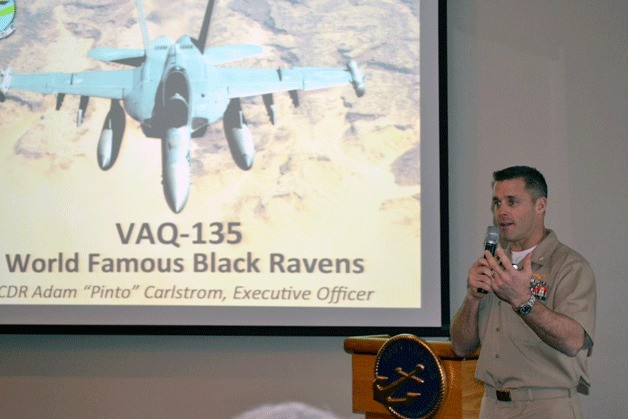The safety risk to carrier-based aircraft squadrons would increase significantly if Navy pilots weren’t able to practice at Coupeville’s Outlying Field.
That’s according to Executive Officer of Electronic Attack Squadron (VAQ) 135, Cmdr. Adam Carlstrom, who addressed members of the Oak Harbor Area Council of the Navy League Tuesday at the Officers’ Club on Whidbey Island Naval Air Station.
Carlstrom was asked to comment on the importance of Outlying Field, a subject of much recent debate. Some residents frustrated with noise from touch-and-go landings at the field started an online petition and are investigating legal options to stop flights at the airstrip.
According to Carlstrom, the airstrip provides pilots with a huge training advantage.
“For carrier-based squadrons, Outlying Field provides the only opportunity to practice where we’re not in everybody else’s way,” he said. “Maintaining proficiency behind the boat is of utmost importance. Coupeville provides us that ability. Without (it) our proficiency would significantly diminish.”
The Black Ravens of VAQ-135 are very familiar with the practice field, as the squadron used to be a carrier-based unit. The squadron became an expeditionary unit following its transition one-and-a-half years ago from the EA-6B Prowler to the EA-18G Growler aircraft. The squadron returned in October following its first land-based deployment to Bagram Airfield in Afghanistan.
“We deployed in April not knowing where we were going,” said Carlstrom, who said personnel at Bagram were not expecting them. “We all lived out of wood shanties or broken down tents for about a month.”
Carlstrom said the Growler platform was new to the personnel at Bagram and one of the hurdles the squadron had to overcome was getting personnel there acquainted to the new platform.
“We were unappreciated,” he said. “But once we’d been there about a month and everybody was over that, it was great.”
The Black Ravens set several milestones during their recent deployment, which was their first expeditionary Growler deployment to Afghanistan and the squadron’s first deployment in the Growler. Also, the squadron saw its first all-female EA-18G combat flight, launched by an all-female ground crew.
As for the rest of VAQ-135’s mission, all but one flight was completed.
“We missed one flight while we were there and it was mine,” Carlstrom said. “That was because we hit a bird. Other than a bird strike, we had no mechanical issues throughout the deployment.”
All told, the Black Ravens completed more than 400 sorties, ranging in length from two hours to more than eight and supported an average of 18 missions a day.
“We would eat, sleep, fly, work out a little bit, eat, sleep, fly, work out a little, and so on,” said Carlstrom. “It was a dream deployment for a Naval aviator.”



